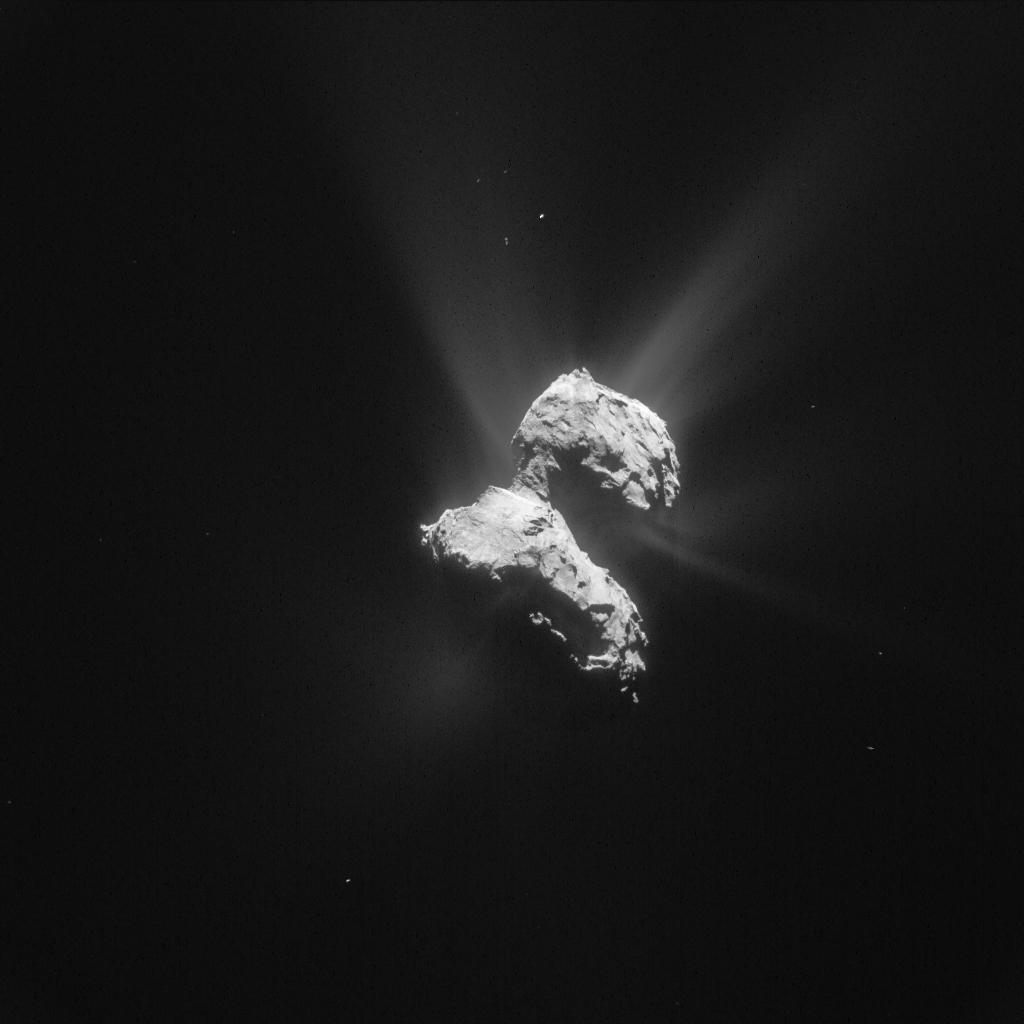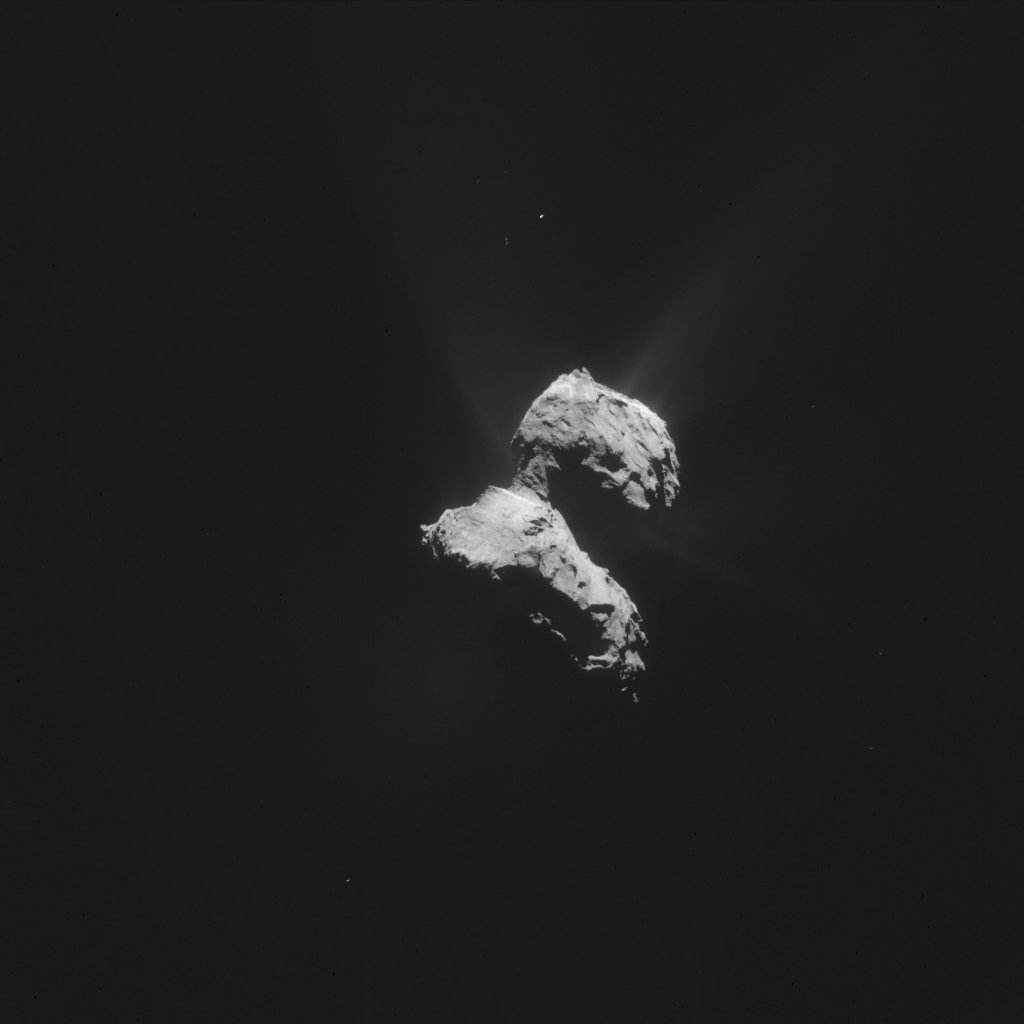This impressive view of Comet 67P/Churyumov-Gerasimenko was captured on 21 May from a distance of 156.8 km from the comet centre. It is a single frame image with a resolution of 13.4 m/pixel, and measures 13.7 km across. The intensities and contrast have been adjusted to emphasise the activity of the comet.

Processed image of Comet 67P/C-G taken by Rosetta’s NAVCAM on 21 May 2015. Credits: ESA/Rosetta/NAVCAM – CC BY-SA IGO 3.0
Activity is seen all around the nucleus, but in this view is most notable around the head, with many distinct, bright jets streaming from the surface. Intricate patterns of activity are also cast around the neck and against the shadow of the small lobe.
The rather flat face on the comet’s large lobe, comprising parts of Aker and Khepry, dominates the view of the nucleus. The elongate Aten region lies adjacent, with diffuse wisps of activity hanging in front of this shadowed depression.
A fainter cloud of activity is also visible below the shadowed underside of the comet’s large lobe.
Today’s image also makes for a nice comparison with the 26 April entry, which shows the comet in a similar orientation.
The original 1024 x 1024 pixel image is provided below:










Discussion: 15 comments
Still jets on the dark side, still bended and still filamentary…
What consensus theory says about it? What where the predictios about it? Where there any?
https://www.esa.int/Our_Activities/Space_Science/Rosetta/Ultraviolet_study_reveals_surprises_in_comet_coma
This is also electrical proces!! Or maby moving electrons is not electric current????? Or I’m wrong? If so, please some one explain it to me….
Moving electrons is not the same as electric current.
Most of the electrons come from neutral molecules by photo-ionization from ultraviolet radiation.
The molecules get a positive charge during this ionization.
The freed electrons may then themselves ionize or decompose other molecules.
The result is a mix of electrons and mostly positively charged ions.
As long as both, electrons and positively charged ions move in the same direction, resulting in the same transport of positive charges as negative charges, there is no electric current at a sufficiently large scale (a few “Debye-length”s, https://en.wikipedia.org/wiki/Debye_length)
If positive charges and negative charges migrate overall in opposite directions you get an electric current.
Randomly moving electrons is not an electric current Gerald but if a potential gradient exists the movement will not be random. The electrons will flow in one direction and the positive ions in the opposite direction. This is a plasma current. And it has been pointed out several times previously in this blog that the electrons will be accelerated more quickly and to higher speeds ( ie lose their randomness) than the more massive positive ions.
The phrase ” a few Debye lengths” has no significance in the context of an electric current. Beyond one Debye length from any charged particle it is effectively shielded and therefore unable to interact with any other charged particle. In a plasma therefore beyond one Debye length charged particles retain their charge and their current carrying capacity.
We have yet to see on this mission any determination or even estimate of Debye length of the plasma anywhere in the coma.
It is incorrect to say the electrons ‘loose their randomness’ faster than the electrons in an applied field, because the protons are heavier, they accelerate more slowly, yes; but they also have lower random thermal velocities because they are heavier. So if the electron and proton temperatures are the same (and they might not be) it cancels out.
Also of course whilst the drift current can be arbitrarily small, to say they ‘loose their randomness’ implies drift energies at least of the order of the electron temperature
BTW they did report some limited data from the plasma instruments a while back; the summary was ‘consistent with a photo ionised plasma’ or words to that effect; I think it included electron temperatures, it certainly included electron densities, so easy to get the Debye length.
Moving on then from Gerald’s assertions to yours Harvey, first of all I think you meant “faster than positive ions”. In a plasma the electron and ion temperatures are rarely the same. Whatever their respective response, once they do respond they constitute a current. That is the point I was making to Gerald. The energies in the plasma current state are likely to be very much higher than represented by the random atom or molecule temperature caused by motion in a gas. Which is why plasma temperatures are typically higher than gas temperatures and why increase in temperature is one way of transforming a gas to a plasma.
It is worth remembering too that the gas temperature model of random motion and collision does not apply to plasma in an electric field where the motion of the ions, positive or negative, is in one distinct direction or the opposite direction. Plasma temperature is a measure of the energy in that motion. It is not the same as gas temperature even though there is no distinction in the terminology.
Regardless of that, the point I was making to Gerald is that moving electrons in a plasma, in an electric field, constitute an electric current, whatever the origin of the electrons.
I do recall the old report you are referring to which I think was a poster publication, which we have discussed before. To date it remains the only published data by ESA on positive ion ( unspecified) density in the coma and possibly electron density too (where there was some mapping). From memory the mean ion density at an unspecified distance from the nucleus was around 300 per cm cubed, and it was described as consistent with photoionisation because there was no evidence that that was the source. I do not recall any comment on electron temperature. We should not however be referring back to that poster. There must be more specific and detailed data available by now, yet to be published but hopefully soon. Presumably when ESA wish to address the significance of Debye length particularly within the comet coma they will calculate it from the data they have and share the figures with us.
Originaljohn, I think we essentially agree about the meaning of an electric current in a plasma. Besides some boundary effects you need an electric field to cause an electric current in a plasma, no matter how ion and electron temperatures are distributed.
Otherwise all you get are local fluctuations, but no large-scale currents.
The electric fields include changing magnetic fields, according to Maxwell (and Faraday).
https://en.wikipedia.org/wiki/Faraday%27s_law_of_induction
https://en.wikipedia.org/wiki/Maxwell's_equations
The visible jets are mostly dust particles, visible by scattering of sunlight.
The Lyman-alpha line of hydrogen is in the ultraviolet, invisible for NavCam. That’s the most prominent source for “intrinsic” uv radiation emitted by ionized hydrogen gas.
The red hydrogen-alpha (of the Balmer series) may also be present, and in priciple visible for NavCam, but it’s very weak in comparison to scattered sunlight.
https://en.wikipedia.org/wiki/Hydrogen_spectral_series
Gas emissions from the nucleus (glowing mostly in ultraviolet) and dust jets (visible for NavCam) are correlated, but not the same thing. The gas drags the dust.
@Lucas,
Everything is an electrical process. Almost everything.
In a Feynman video I watched a while back, he was talking about the electromagnetic force… He said, if you were trying to describe the force to someone, and you say “well, it’s like a rubber band”, you are in fact making a circular description because the rubber band is held together by the electromagnetic force.
So there are electrons, and there are atomic nuclei, and in this cold lump of dark matter that is the comet, 99.999%+ of the electrons are but a part of neutral molecules. Rosetta didn’t detect much of a magnetic field, nor much ionization. Sunlight on some of the escaping molecules has ionized a few, and that is how we can see the comet’s composition in infrared/visible/ultraviolet spectra. But the vast majority of the molecules are cold and dark and only visible by their effect on the illuminated few.
So far, the ‘bending’ we have observed can easily be explained by a combination of the comet spinning as it emits this dusty gas, and interactions between multiple jets, especially in the neck region, where they push against each other after leaving the surface.
More evidence of intrinsic illumination of jets, this time from widely separated regions, the neck and as you observe Emily “A fainter cloud of activity is also visible below the shadowed underside of the comet’s large lobe”. Very interesting. Any measurements focused on these jets ?
Ionization and recombination are electromagnetic processes, but not to be confused with electric currents.
There exist many different electromagnetic processes.
Hi Graham,
your comments look a bit random I am not even sure what message you are trying to get across.
We have just had a new paper published, its time to lighten up, we have been waiting for new papers for a while now, maybe we could even discuss the surprises that were found in the paper.
No particular message, I just recommend to learn or look up the meaning of some basic physical notions.
There is no warranty, that Wikipedia is always correct. But in most cases it provides at least an idea of what the notion means.
The physics on an atomic scale can be counter-intuitve. But some understanding of the basics is necessary to understand the papers.
Reading an introduction to quantum physics may help:
https://en.wikipedia.org/wiki/Introduction_to_quantum_mechanics
The emission in the shadow of Imhotep still seems fuzzier when viewed from the night side.
Kamal,
“Dustlight”
Not glowing in visible spectrum.
Ramcomet: Thanks, I did not think of that.
Kamal